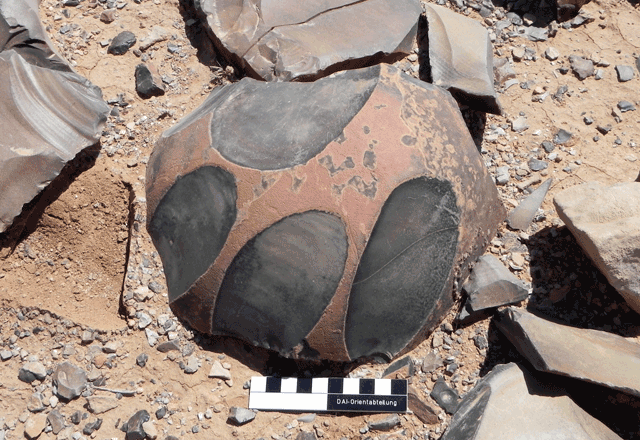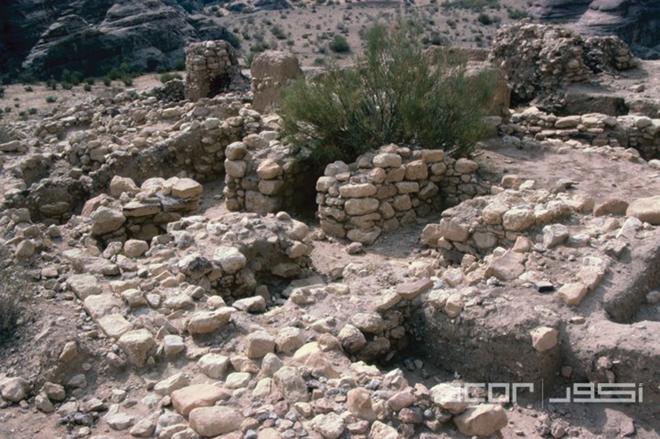You are here
Ancient settlements: Delving into ecological marginality of southern Jordan, northern Badia
By Saeb Rawashdeh - Apr 19,2024 - Last updated at Apr 19,2024

Petra rock-cut architecture seen from ad Deir (Photo courtesy of ACOR)
Since the Bedouin life-style was adapted to the area’s ecological marginality, the marginality percentage for this early phase is not as elevated as is the case in the following periods, noted Stephan Schmid from Humboldt University, adding that the political importance of the site was low.
“Since the nomadic way of life was adapted to the environmental situation, economic and social marginality can be considered low. Historical and archaeological sources indicate that the first efforts undertaken towards transforming Petra into a permanently inhabited place were made in the 4th to 2nd centuries BC,” Schmid underlined, adding that the archaeological record clearly indicates how difficult the struggle with the seasonal flash floods was.
Thus, the ecological marginality of the location increased considerably when the occupants of the site decided to settle there permanently.
The turning moment happened during the 1st century BC, when Nabataeans built a system that could control seasonal the flash floods as well as the water supply from the Shara Mountains.
“Interestingly, there seems to be no logical reason why the Nabataeans maintained what had once been a non-permanent settling place as a permanently occupied central place, since it would have been possible to find sites much better suited for the establishment of an urban centre only a few kilometres away,” Schmid said, adding that it would appear, therefore, that some kind of emotional tie to the site was operating.
After the Roman annexation in AD 106, Petra remained a permanently occupied central place but lost its status as a capital of a political entity. Due to the environmental situation, the permanently inhabited settlement can still be considered ecologically marginal, and, due to the loss of its unique status, the new administration had less of an interest in maintaining the immense efforts that had to be undertaken to guarantee a permanently high living standard, he said, adding that this resulted in a slow decline in living quality.
“Due to the loss of its function as a capital, Petra’s political marginality increased, as did its economic marginality, since greater emphasis was placed on diversification in long-distance trade in this period than in the previous one,” Schmid noted.
On the other hand, the Northern Badia in north-eastern Jordan forms part of the greater steppe desert, which is located between the Middle Euphrates (Mesopotamia) and the Southern Levant. Due to the modern climatic conditions, characterised by low and seasonal rainfall, the region can be considered as ecologically marginal. However, the precipitation was much higher during the Neolithic period.
“During the Late Neolithic period [LN- approximately 7000 to 5000 BC] the population of Northern Badia consisted of indigenous hunter-gatherers and incoming pastoralists, or mobile hunter-herders, whose material culture is associated with a vast number of archaeological sites, including traps for hunting animals [known as ‘kites’] and seasonal camp sites,” Schmid elaborated, adding that the LN economy was pursued on a seasonal basis, concentrating mainly on intensive gazelle hunting and pastoralism and perhaps on periodical agriculture.
These economic activities were primarily subsistence oriented and almost met the demands of the local population.
“The existence of exchange contacts between the populations of different regions cannot be ruled out, a factor which would lower automatically this economic marginality,” said Schmid, adding that various parts of the Northern Badia were characterised by different topographic and ecological conditions.
“Recent archaeological and geographical surveys indicate that the economic activities in the entire region were characterised by the production and trade of flint tools, pastoralism and agriculture,” Schmid said, noting that the basaltic region of the Northern Badia was frequently used as pasture by mobile pastoralists, as indicated by the remains of numerous camp sites with animal pens.
Moreover, intensive agricultural activities are indicated by the existence of several presumably agriculturally used terraced gardens in the close vicinity of the settlements of Jawa and Tulul Ghusayn, and a large flint mining region in the eastern part of the Northern Badia shows intensive mining and export-oriented tool blank production activities.
The economic value of the mines however, was not marginal at all, since the production of characteristic flint tools in these mines was clearly supra-regional export-oriented.
“Thus, Northern Badia as a whole, was therefore economically not marginal, but the level of local economic marginality was related to the economic activity. The level of the spatial marginality of the various parts of the region also varied, but it can be considered to fall at mid-range for the entire region on the average. No information on the social marginality is available,” Schmid underscored.
During their history, the settlements underwent changes with respect to types of social, political and spatial marginalities.
“However, deforestation and unsuitable land use frequently caused land degradation and deterioration of site conditions — especially in ecologically favoured regions — and thereby caused an increase of ecological marginality,” Schmid said.
Related Articles
AMMAN — Flint tools, also called cortical scrapers, found in the Northern Badia offer clues to animal husbandry during the Early Bronze Age
AMMAN — The Neolithic period is rich in archaeological remains that show most of the fundamental developments in human history, noted a Jord
AMMAN — The southeast part of Jordan has not been excavated enough in the past.



















